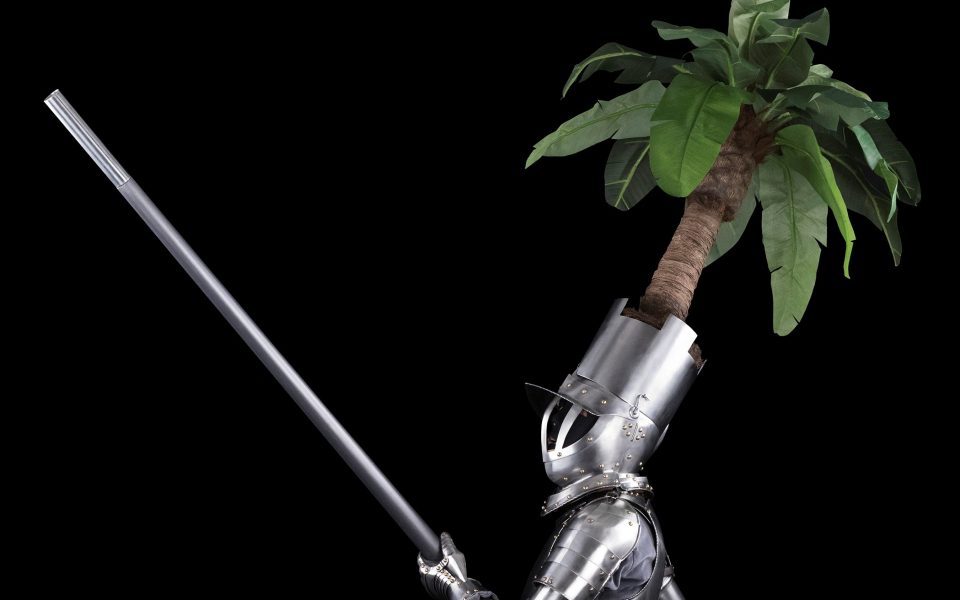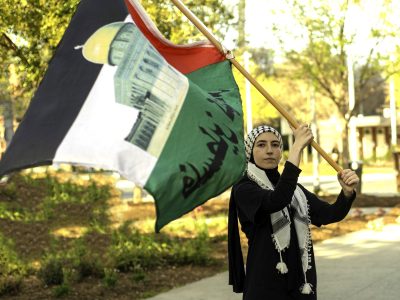Featured photo: Lorraine O’Grady (American, born 1934). Announcement Card 1 (Banana-Palm with Lance), 2020. Fujiflex print, 60 × 40 in. (152.4 × 101.6 cm). Edition of 10 plus 3 artist’s proofs. Courtesy of Alexander Gray Associates, New York. © Lorraine O’Grady/Artists Rights Society (ARS), New York

It’s all too much.
Twenty-two months of a global pandemic that has claimed the lives of more than 5 million people worldwide. The exacerbated racial, social and economic inequalities that have bared their ugly teeth in the midst of it all. The ongoing crisis of a warming and steadily degrading environment at the hands of humankind’s manipulations.
And yet, in the quiet stillness of the Weatherspoon Art Museum’s upper galleries, artist Lorraine O’Grady offers space for curious introspection and analytical extrospection in her retrospective, Both/And.
On loan from the Brooklyn Museum, the show is the first comprehensive overview of the work of O’Grady, who is considered to be one of the most significant figures in contemporary art. Born in Boston to Jamaican parents, O’Grady led various lives prior to becoming an artist, including work as an intelligence analyst for the US government and a rock critic for the Village Voice and Rolling Stone. The show, which opened at the Weatherspoon on Saturday and runs through April 30, includes much of O’Grady’s prominent visual works including photographs of her performance art, collages and a short film, all which result from four decades of her artistic career which she began as a 45-year-old.
In the first section of the main gallery, photographs capturing O’Grady’s “Rivers, First Draft,” performance in Central Park in 1982 span the walls. Figures clothed in bright primary colors, including the artist in red, prance and dance within the wooded pockets of the park, telling a vague autobiography. The work, as exhibited by the title, was meant to be a first in a series of three performances, two of which never took place. And while the performance itself happened in 1982, the still images capturing the scenes weren’t processed and displayed in an exhibition until in 2015. This act of returning to her older works is a quintessential part of O’Grady’s process as an artist.

“What Lorraine O’Grady really presents to all of us is that there isn’t one answer, there isn’t one way of being and even your work itself is never a final statement,” explains Juliette Bianco, the museum’s new director. “You can go back to it. You can revise it and you can learn, and I feel that all of her practice helps us open our minds to the possibility of ways of being that’s more inclusive of the possibility of, What if it’s not just this?”
Throughout the exhibit, this idea of returning to, revising and recreating plays a recurring theme throughout O’Grady’s work. In fact, one of the set pieces used in “Rivers, First Draft” makes an appearance more than 30 years later in one of the artist’s most recent works, “Announcement of a New Persona.”
The towering, dramatic photographs of O’Grady donning a shiny suit of armor in front of a stark black background draw the eye’s attention to the back of the gallery. The pieces, like much of the artist’s work, take place over several scenes with O’Grady posing in her outfit, with a voluminous palm frond sticking out of the top of her helmet. According to Weatherspoon Curator Emily Stamey, the frond is a call back to “Rivers, First Draft,” and signifies O’Grady’s Caribbean heritage juxtaposed with the armor which symbolizes European conquest and colonialism. The work is also a new persona that O’Grady has created to spread her message, the most famous persona of hers being “Mlle Bourgeoise Noire.”

Debuted in 1980, O’Grady donned the character of Mademoiselle Bourgeoise Noire, or “Miss Black Middle-Class” to disrupt significant spaces within the art world. Dressed in a costume made up of 180 pairs of white gloves while carrying a white cat-o-nine-tails whip, Mlle Bourgeoise Noire would crash locations like the New Museum, a largely white institution, to protest racial segregation in the art world. In 1983, she performed as Mlle Bourgeoise Noire in the annual African American Day Parade in Harlem, where she and other artists dressed all in white rode a parade float adorning a large, wooden picture frame. At the same time, she and the other artists carried around empty frames which they held up to members of the crowd, casting them as works of art.
“There’s that act of flipping it around,” Stamey explains. “But then also the flipping on herself I think is just as equally important. The works are deeply, deeply personal and it is her figuring out, reflecting upon and sharing with others what it means for her to be a Black woman in the world…. So much of it is about her personal story so her body becomes the anchor for how she talks about that.”
-

Lorraine O’Grady (American, born 1934). Mlle Bourgeoise Noire celebrates with her friends, from Mlle Bourgeoise Noire Goes to the New Museum,1980–83/2009. Silver gelatin fiber photograph, 7 × 9.31 in. (17.78 × 23.65 cm). Edition of 8 plus 2 artist’s proofs. Courtesy of Alexander Gray Associates, New York. © Lorraine O’Grady/Artists Rights Society (ARS), New York -

Lorraine O’Grady (American, born 1934). Art Is . . . (Girl Pointing), 1983/2009. Chromogenic photograph in 40 parts, 20 × 16 in. (50.8 × 40.64 cm). Edition of 8 plus 1 artist’s proof. Courtesy of Alexander Gray Associates, New York. © Lorraine O’Grady/Artists Rights Society (ARS), New York
Throughout the show, it becomes evident that one of the lasting impressions of O’Grady’s creative mind — which undulates between the past and present, Black and white, the personal and external — is its ability to be self-reflective and self-aware, even to the point of returning to work that she created decades ago for reconsideration.
And in our current world in which society has become so fractured into factions of us versus them, I versus the whole, wrong versus right, O’Grady’s open-ended interpretation of both herself and the world around her offers spaces of awareness and compassion.
“We need to as humans living with each other in the world, be able to think and see and feel beyond limited either/or categories,” Stamey says. “And [O’Grady] does that in every single work. She pushes you to see things as not just this or that, but both of those things and then something more.”
To view the exhibit, visit the museum on Tuesdays through Saturdays from 10 a.m. to 5 p.m. On Thursdays, the museum is open until 8 p.m.
Visitors can join docent tours every Saturday afternoon from 1-1:30pm for the O’Grady exhibition through April 30.
A virtual conversation between Lorraine O’Grady and poet Alexis Pauline Gumbs will take place on March 24 at 5:30 p.m. Learn more and register at weatherspoonart.org.
Join the First Amendment Society, a membership that goes directly to funding TCB‘s newsroom.
We believe that reporting can save the world.
The TCB First Amendment Society recognizes the vital role of a free, unfettered press with a bundling of local experiences designed to build community, and unique engagements with our newsroom that will help you understand, and shape, local journalism’s critical role in uplifting the people in our cities.
All revenue goes directly into the newsroom as reporters’ salaries and freelance commissions.





Leave a Reply